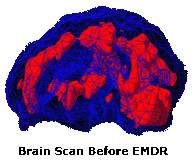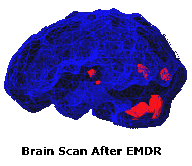“I carried the grief of my son’s death for 15 years. The pain left in one session of EMDR and has never come back.”
Stephanie Kowalski, Pukalani, HI
What is Eye Movement Desensitization & Reprocessing?


Before and after EMDR brain scans. Left photo shows woman with Post Traumatic Stress Disorder. Right photo shows same patient after four ninety minute EMDR sessions. The red areas indicate overactivity in the brain. Photo by Dr. Daniel Amen
Eye Movement Desensitization and Reprocessing (EMDR) is a treatment that was originally developed to alleviate the distress associated with traumatic memories. EMDR helps a person to access and process traumatic memories and to resolve them. After successful treatment with EMDR, emotional distress is relieved, positive beliefs are formed, and physical symptoms are reduced. During EMDR the client focuses on emotionally disturbing material in brief doses while simultaneously focusing on an external stimulus. The external stimulus could be eye movements, hand tapping, or tones. EMDR enhances information processing and creates new associations between the traumatic memory and more adaptive memories or information. These new associations result in complete information processing, new learning, eliminating emotional distress, and developing insights.
Is EMDR an effective treatment for Post Traumatic Stress?
Yes. EMDR is the most researched psychotherapeutic treatment for PTSD. Twenty controlled outcome studies have investigated the efficacy of EMDR in PTSD treatment. EMDR has been found to be superior to biofeedback relaxation, active listening, group therapy,and various forms of individual therapy, including Cognitive-Behavioral Therapy.
How many Sessions will it take?
It varies with each client, but a single event, such as an assault or car accident can take from one to three sessions. More long-term exposure to trauma, such as ongoing domestic violence, can take about 6 sessions.
For more information, visit www.EMDR.com

